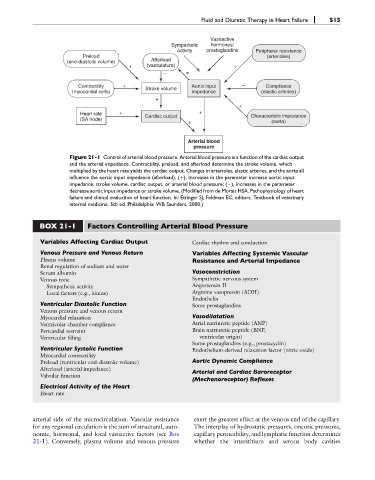Page 527 - Fluid, Electrolyte, and Acid-Base Disorders in Small Animal Practice
P. 527
Fluid and Diuretic Therapy in Heart Failure 515
Vasoactive
Sympathetic hormones/
activity prostaglandins Peripheral resistance
Preload (arterioles)
(end-diastolic volume) Afterload
+ (vasculature) +
– =
Contractility + Stroke volume Aortic input – Compliance
(myocardial cells) impedance (elastic arteries)
+
+
Heart rate + Cardiac output + Characteristic impedance
(SA node)
+ (aorta)
Arterial blood
pressure
Figure 21-1 Control of arterial blood pressure. Arterial blood pressure is a function of the cardiac output
and the arterial impedance. Contractility, preload, and afterload determine the stroke volume, which
multiplied by the heart rate yields the cardiac output. Changes in arterioles, elastic arteries, and the aorta all
influence the aortic input impedance (afterload). (þ), Increases in the parameter increase aortic input
impedance, stroke volume, cardiac output, or arterial blood pressure; ( ), increases in the parameter
decrease aortic input impedance or stroke volume. (Modified from de Morais HSA. Pathophysiology of heart
failure and clinical evaluation of heart function. In: Ettinger SJ, Feldman EC, editors. Textbook of veterinary
internal medicine, 5th ed. Philadelphia: WB Saunders, 2000.)
BOX 21-1 Factors Controlling Arterial Blood Pressure
Variables Affecting Cardiac Output Cardiac rhythm and conduction
Venous Pressure and Venous Return Variables Affecting Systemic Vascular
Plasma volume Resistance and Arterial Impedance
Renal regulation of sodium and water
Serum albumin Vasoconstriction
Venous tone Sympathetic nervous system
Sympathetic activity Angiotensin II
Local factors (e.g., kinins) Arginine vasopressin (ADH)
Endothelin
Ventricular Diastolic Function Some prostaglandins
Venous pressure and venous return
Myocardial relaxation Vasodilatation
Ventricular chamber compliance Atrial natriuretic peptide (ANP)
Pericardial restraint Brain natriuretic peptide (BNP,
Ventricular filling ventricular origin)
Some prostaglandins (e.g., prostacyclin)
Ventricular Systolic Function Endothelium-derived relaxation factor (nitric oxide)
Myocardial contractility
Preload (ventricular end-diastolic volume) Aortic Dynamic Compliance
Afterload (arterial impedance) Arterial and Cardiac Baroreceptor
Valvular function
(Mechanoreceptor) Reflexes
Electrical Activity of the Heart
Heart rate
arterial side of the microcirculation. Vascular resistance exert the greatest effect at the venous end of the capillary.
for any regional circulation is the sum of structural, auto- The interplay of hydrostatic pressures, oncotic pressures,
nomic, hormonal, and local vasoactive factors (see Box capillary permeability, and lymphatic function determines
21-1). Conversely, plasma volume and venous pressure whether the interstitium and serous body cavities

